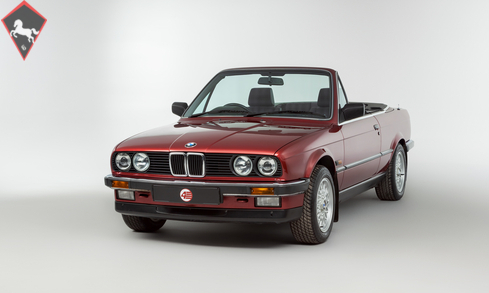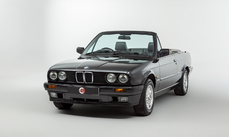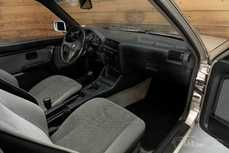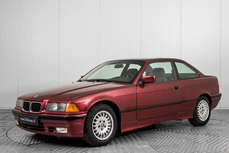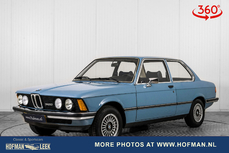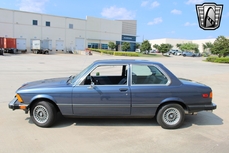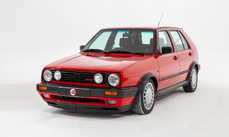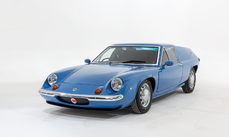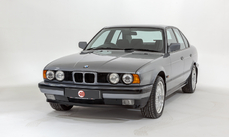BMW 320 320i Convertible 1990
Allgemeine Beschreibung :
Model History
Replacing the E21 chassis in 1982 the E30 chassis spanned twelve years of production and overlapped its successor – the E36 introduced in 1990 – by 4 years.
Early models featured the four-pot M10 and straight-six M20 engines used in the E21. The major update for the E30 took place in 1987 where the M20 engine was fitted with Bosch Motronic injection and the M10 engine replaced with the M40 engine again utilising Motronic. The chrome bumpers were also replaced with black ones in late 89 and the rear light made slightly bigger during this minor face lift.
The E30 was credited with a spacious cabin and a light curb weight, this was due to the suspension design that utilize Macpherson front struts and rear semi trailing arms. It was also the first 3 series to receive a service light indicator and warning light.
The 325i convertible was the first drop top solely built by BMW closely followed by the 320i convertible. The early E30 convertibles were converted by Baur, a coachbuilder located in Stuttgart credited with early full factory authorization. To strengthen the chassis and reduce scuttle shake BMW added plates to the front suspension turrets and built-in chassis beams down the length of the car helping to reduce flex or twist in the chassis after removing the metal roof.
Equipment
Calypso Red Metallic, Anthracite cloth upholstery, Soft-top in black, Chrome bumpers, 15-inch cross-spoke alloys, 4-speed automatic gearbox, M Tech II steering wheel, Dash clock, Outside temperature display, Heated door mirrors, Panasonic cassette radio, Tailored carpet mats, Front and rear mud flaps, BMW toolkit, Alloy spare wheel, Jack and wheel brace, Warning triangle.
Exterior
This outstanding E30 really looks the part with its original Calypso Red paint, chrome bumpers and 15-inch BBS alloys. The car is arrow-straight along both sides and presents without any scratches or damage to the paintwork. Glancing along those classic lines all of the trim remains in excellent original condition. The brightwork maintains a lovely mirror finish and the bumpers are in very good order. Furthermore, the hood is unworn with zero damage to the rear window. There is no rust to speak of, and the registration number can still be found etched on all glass. A truly fantastic example and a car we know well having sold it to the current owner.
VIEWINGS WELCOME BY APPOINTMENT ONLY /// ADDITIONAL PHOTOS AVAILABLE UPON REQUEST
Interior
The sports seats look fantastic in anthracite cloth. The upholstery is unworn and presents without any marks or unsightly sagging to the bolsters or seat bases. With a mere 51k miles to its name the cabin appears fresh throughout, and certainly free from any signs of heavy use. Commonly worn items such as the steering wheel and switchgear are in fine order with no damage to report. A full set of tailored overmats protects the foot-well carpets, and in the boot you’ll still find the toolkit, warning triangle, and refurbished spare wheel.
ENGINE & TRANSMISSION
The engine bay of this example is particularly sound. Having been carefully stored when not in use car has never suffered from corrosion in any of the usual E30 weak spots such as the suspension turrets and inner wings. Furthermore, the service booklet boasts a great maintenance history, which is stamped at close mileage intervals. Following some downtime in dry storage the cambelt was replaced in 2017; the car has been serviced twice more since then, first an Inspection II at BMW in 2019 and most recently an oil service in June 2021 at 50k miles.
WHEELS, TYRES & BRAKES
The desirable 15-inch BBS cross-spoke alloys look great on the 320i and were specified from new. They present in immaculate condition having previously been fully refurbished to the highest standards. They are shod in a new set of Goodyear tyres (not pictured) that were fitted in June 2021. The brakes have also been checked and remain in fine operational condition, bringing the car to a halt quickly and in a straight line.
History File
Costing £22,051 the E30 was supplied new in May 1990 by Alan Kerr Ltd, Warwick. Alan Kerr BMW also carried out the running-in inspection and subsequent six services; the next three were also at main dealers. Maintenance has been carried out at close mileage intervals, with the last service having only recently been done in June this year. The dense history file is complete with the original document pack, radio instructions, raft of invoices and plenty of old MOT certificates.
Services have been carried out at the following mileages: 577 (Running-in inspection) – 3,657 (Oil service) – 8,227 (Inspection I) – 12,855 (Inspection II) – 18,254 (Oil service) – 24,634 (Oil service) – 28,625 (Inspection I) – 33,429 (Oil service) – 36,587 (Inspection II) – 43,167 (Oil service) – 43,931 (Inspection I) – 50,000 (Oil service + cambelt) – 50,667 (Inspection II) – and most recently an oil service in June 2021 at 50,831 miles.
http://www.4starclassics.com/for-sale/bmw-e30-320i-convertible-for-sale/
1990 BMW 320 320i Convertible is listed verkauft on ClassicDigest in Kingsley by 4 Star Classics for £16995.
Fakten der Auto
Karosserietyp : Auto Marke : BMW Modell : 320 Ausführung : 320i Convertible Hubraum : 2.0 Modelljahr : 1990 Karosstyp : Convertible Lage : Hampshire
Verkauft
Angaben Zum Verkäufer
Verkauft
People who viewed this BMW 320 also viewed similar BMW listed at ClassicDigest
Other cars listed for sale by this dealer
über BMW
Bayerische Motoren Werke, allgemein bekannt als BMW, hat eine reiche Geschichte, die bis zu ihrer Gründung im Jahr 1916 zurückreicht. Ursprünglich als Flugzeugmotorenhersteller während des Ersten Weltkriegs gegründet, sah sich BMW nach dem Krieg Beschränkungen bei der Flugzeugproduktion gegenüber. Als Reaktion darauf verlagerte das Unternehmen 1923 seinen Fokus auf die Motorradproduktion, was den Beginn seiner Beteiligung an der Automobilindustrie markierte. Anschließend stieg BMW 1928 in die Welt der Automobile ein, indem es den DIXI produzierte, im Wesentlichen eine lizenzierte Version des Austin 7 von der Austin Motor Company.In den 1930er Jahren begann BMW, sich als Hersteller von eleganten und leistungsstarken Fahrzeugen zu etablieren. Ein bemerkenswertes Modell aus dieser Zeit ist der BMW 327, der 1937 eingeführt wurde. Der 327 war sowohl als Coupé als auch als Cabriolet erhältlich und zeigte das Engagement der Marke für Luxus und Stil. Darüber hinaus erzielte BMW in dieser Zeit im Sportwagenrennsport Erfolge, insbesondere mit dem BMW 328. Der 328, der 1936 debütierte, wurde für seine Leistung und Aerodynamik bekannt. BMW setzte den 328 in verschiedenen Rennveranstaltungen ein, darunter die prestigeträchtige Mille Miglia, bei der das Unternehmen mehrere aerodynamische Spezialmodelle präsentierte.
Die Nachkriegszeit erwies sich für BMW als herausfordernd, und das Unternehmen sah sich finanziellen Schwierigkeiten gegenüber, die beinahe zu einem Konkurs führten. Dennoch gelang es BMW, sich zu erholen und wieder aufzubauen und schließlich zu einer der führenden Premium-Automarken weltweit zu werden.
Als die 1960er Jahre begannen, festigte BMW weiter seinen Ruf als Hersteller von sportlichen und luxuriösen Fahrzeugen. Im Jahr 1968 wurde der BMW 2002 eingeführt und markierte die Geburt der "Neuen Klasse" kompakter, sportlicher Limousinen. Der 2002 erlangte Popularität durch sein agiles Handling und seine Leistung und legte den Grundstein für das sportliche Image von BMW.
Mit den 1970er Jahren erweiterte BMW seine Modellpalette mit der Einführung der E9-Plattform, zu der der ikonische BMW 3.0 CS Coupé gehörte. Die E9-Serie zeigte das Engagement von BMW für die Verbindung von Leistung und Luxus. Im Jahr 1972 feierte der M1, das erste mittelmotorgetriebene Sportwagen von BMW, sein Debüt. Der M1 wurde zunächst als Rennwagen entwickelt, wurde aber später auch als Straßenfahrzeug angeboten. Der M1 legte den Grundstein für die leistungsstarke M-Serie von BMW.
Ende der 1970er Jahre wurde die BMW E24 6er-Reihe eingeführt, die eine Kombination aus Luxus und Leistung bot. Die 6er-Reihe umfasste Modelle wie den 630CS, 633CSi und 635CSi und wurde zum Symbol für Eleganz und Fahrvergnügen.
Durch diese Meilensteine und das Engagement für Innovation und Leistung hat sich BMW zu einem Schwergewicht in der Automobilindustrie entwickelt und behauptet weiterhin seinen Status als eine der führenden Premiummarken weltweit.
